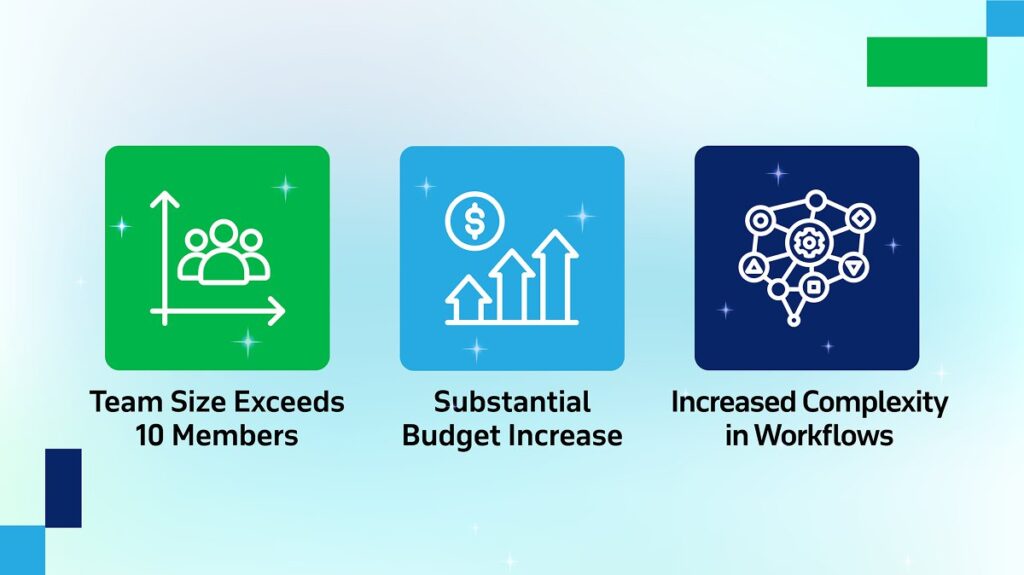Determining the correct Scrum team size is vital to building efficient, high-performing teams that deliver effective healthcare software solutions. As a framework, Scrum emphasizes small, cross-functional teams collaborating to achieve a single Product Goal through iterative development and continuous feedback.
For healthcare technology companies, structuring a Scrum team correctly impacts regulatory compliance, development speed, and product quality. A well-balanced squad ensures smooth coordination between developers, product owners, and Scrum masters, allowing for faster iterations, improved stakeholder communication, and adherence to industry regulations, such as HIPAA and FDA guidelines.
Let’s explore the ideal Scrum team size, when to split a growing team, and how to structure roles effectively, ensuring success in healthcare software development.
What is a Scrum Team?
A Scrum Team is a small, cohesive, and self-organizing unit of professionals dedicated to achieving a single Product Goal. Rooted in Agile principles, the Scrum framework breaks work into manageable timeframes known as sprints, typically lasting around two weeks to solve complex problems iteratively. As outlined in the Scrum guide, a Scrum Team consists of three key roles:
- Developers: The experts responsible for turning ideas into working software.
- Product Owner: The visionary who prioritizes the work and aligns it with the overall product vision.
- Scrum Master: The facilitator who ensures the Scrum process is followed and helps remove any obstacles.
In the realm of healthcare software development, the challenges are unique. From stringent regulatory requirements to the need for rapid innovation, Scrum offers distinct advantages:
- Regulatory Compliance: Healthcare products must meet rigorous standards like HIPAA, SOC, and FDA regulations. Scrum’s iterative process allows teams to integrate compliance checks continuously throughout the development cycle, ensuring that each incremental release meets the necessary legal and security standards.
- Rapid Iteration: In a fast-paced healthcare environment, feedback from clinicians, patients, and other stakeholders is critical. Scrum enables frequent delivery of working software, which allows teams to adapt quickly and incorporate valuable feedback, ensuring that the end product evolves in alignment with user needs.
- Cross-Functional Collaboration: Developing healthcare software requires a holistic approach that blends clinical insight, robust data security, and intuitive user experience design. By bringing together experts from diverse fields into one cohesive team, Scrum ensures that all facets of healthcare technology are addressed comprehensively, fostering innovative solutions that are both safe and effective.
By leveraging the structured yet flexible nature of Scrum, healthcare software development teams can deliver high-quality, compliant, and user-centric solutions that keep pace with the demands of modern healthcare.
What Is The Correct Scrum Team Size?
According to the Scrum guide, a Scrum Team should consist of ten or fewer people. This guideline helps maintain a manageable scope of communication and collaboration within the team. Here’s how the numbers typically break down:
Small Projects:
- 3 Developers
- 1 Product Owner
- 1 Scrum Master
Total: 5 team members
Large Projects:
- 7 Developers
- 1 Product Owner
- 1 Scrum Master
Total: 9 team members
Splitting the group into two connected teams is recommended if a team grows beyond ten people. These teams would share the same Product Owner, Product Goal, and Product Backlog while running their sprints individually.
Starting small is key. A smaller team simplifies communication and collaboration and ensures a more transparent distribution of responsibilities. An ideal Scrum team size is around seven people for large enterprise projects, while very small projects might run effectively with four members (1 Product Owner, 1 Scrum Master, and 2 Developers). Teams smaller than this may encounter too much overhead in managing Scrum activities.
Tip: Keep your teams simple and consistent. Avoid creating new roles or adding temporary team members unless necessary, as this can complicate the process rather than enhance it.
By adhering to these guidelines, you can ensure that your Scrum teams remain agile, efficient, and well-suited to handle the demands of dynamic project environments.
When Should You Form a Second Team?
Scrum operates under the 3-5-3 rule, which structures teams and workflows efficiently:
- 3 Roles: Scrum Master, Product Owner, Development Team
- 5 Events: Sprint, Sprint Planning, Daily Scrum, Sprint Review, Sprint Retrospective
- 3 Artifacts: Product Backlog, Sprint Backlog, Increment

These principles keep Scrum teams agile, collaborative, and effective. However, as a team grows, it can reach a point where communication and collaboration become inefficient, this is when forming a second team becomes necessary.
Key Indicators for Splitting a Scrum Team

1. Team Size Exceeds 10 Members
- According to the Scrum Guide, any team larger than 10 people should be split to maintain efficiency.
- When a team surpasses this threshold, communication pathways multiply exponentially, making alignment more complex.
- A team of 5 members has 10 relationships, while a team of 9 has 39 relationships, beyond this, collaboration becomes challenging.
2. Substantial Budget Increase
- Splitting into multiple teams is necessary if your company secures new investment or expands the product scope, resulting in a 3x or larger team growth.
- However, the decision becomes less evident if the growth is incremental (e.g., from 7 to 11 people).
- While Agile values small teams, it also prioritizes individuals and interactions over processes and tools, having multiple teams will naturally introduce more process overhead.
3. Increased Complexity in Workflows
- When a team struggles to manage dependencies, backlog items become bottlenecks, or multiple work streams begin competing for priority, it may be time to create a second team.
- Ensuring each team can operate independently while working towards the same Product Goal helps maintain productivity.
How to Structure Multiple Scrum Teams

When a team splits, both teams should:
- Share the same Product Owner, Product Goal, and Product Backlog
- Conduct sprints individually but synchronize when necessary
- Maintain a cross-functional balance to avoid siloed teams
Splitting a Scrum team isn’t just about numbers, it’s about maintaining efficiency, communication, and the ability to deliver high-value healthcare software without unnecessary complexity.

Key Roles in a Scrum Team
A well-structured Scrum team is essential for delivering secure, compliant, and user-centric healthcare software. Each role is crucial in ensuring smooth development, clear priorities, and alignment with business and regulatory requirements.
1. Product Owner
The Product Owner is the primary link between the business, stakeholders, and the development team. This person ensures that the Scrum team is delivering the most valuable features in alignment with customer needs, regulatory requirements, and business goals. This means prioritizing compliance with HIPAA, SOC 2, and FDA guidelines for healthcare software, ensuring that development efforts always align with security and regulatory standards.

Beyond setting priorities, the Product Owner manages the Product Backlog, which serves as the team’s source of truth for upcoming development tasks. While backlog contributions can come from multiple sources, including clinicians, compliance officers, and business leaders, the Product Owner has the final say on what gets developed first. This is particularly important in the healthcare industry, because system updates must account for clinical workflows, patient data security, and medical professionals’ usability.
Additionally, the Product Owner plays a significant role in release management, determining when and how software updates reach users. Since healthcare applications often integrate with electronic health records (EHRs), telemedicine platforms, and insurance systems, updates must be strategically rolled out to minimize disruptions while ensuring compliance with medical regulations.
2. Scrum Master
The Scrum Master is responsible for maintaining the integrity of the Scrum framework, ensuring that the team follows Agile principles effectively. This role is essential for keeping cross-functional teams aligned in a healthcare software environment, as these teams often include software engineers, cybersecurity specialists, UX designers, and healthcare compliance experts.

One of the Scrum Master’s primary responsibilities is removing blockers that slow development. In healthcare, these blockers can range from complex data security policies to integration challenges with existing hospital systems. The Scrum Master actively works to resolve these issues, ensuring that the team remains focused on delivering functional, high-quality software.
Additionally, the Scrum Master promotes transparency and empiricism, two core Scrum principles. Transparency ensures that all team members, including clinicians, regulatory experts, and developers, clearly understand the project’s progress. Empiricism, on the other hand, enables teams to learn from real-world usage and feedback. Empiricism is particularly valuable in healthcare software where usability by doctors, nurses, and patients can significantly impact adoption and effectiveness.
3. Developers
The development team is composed of professionals who transform ideas into secure, scalable, and user-friendly healthcare applications. While the term “developers” typically refers to software engineers, a complete Scrum development team often includes UX designers, data engineers, system architects, and compliance experts, especially in regulated industries like healthcare.

Unlike traditional teams where tasks are assigned top-down, Scrum developers self-organize, determining the best approach to implementing features while adhering to Agile principles. This flexibility is beneficial in healthtech, where features are designed for clinical efficiency, HIPAA-compliant data processing, and accessibility for diverse user groups.
Collaboration is key within the development team. Given the complexity of healthcare software, developers must work closely with health informatics specialists, cybersecurity teams, and regulatory consultants to ensure that every feature is both technically sound and compliant with industry regulations.
4. The Business Team
Although not an official part of the Scrum team, the business team plays a critical role in defining the broader strategic goals of the product. In healthcare technology companies, this team often includes executives, sales leaders, and industry experts who provide insights into market demands, competitor strategies, and regulatory trends.

The business team bridges product development and market needs, ensuring that software solutions align with hospital procurement strategies, insurance billing structures, and evolving healthcare regulations. While the Product Owner translates these insights into a backlog, the business team ensures that the company’s broader strategic vision is reflected in development priorities.
5. Subject Matter Experts (SMEs)
Subject Matter Experts (SMEs) provide specialized knowledge that guides the Scrum team’s decision-making. In healthcare software development, SMEs often include clinicians, medical billing specialists, healthcare IT professionals, and regulatory advisors. These individuals are not permanent Scrum team members but are consulted regularly to ensure that features meet industry standards and practical usability requirements.
For example, if a team is developing an AI-driven diagnostic tool, an SME from a radiology department may provide insights into how radiologists analyze medical images, what kind of automation they trust, and what compliance regulations apply to AI in diagnostics. Similarly, if an EHR system is being enhanced, an SME specializing in FHIR and HL7 interoperability standards would ensure that the solution integrates seamlessly with hospital infrastructure.

Although SMEs provide essential input, they are not responsible for execution. Their primary role is to answer questions, validate requirements, and ensure that the end product meets both technical and clinical expectations.
Building an effective Scrum team for healthcare software requires the right mix of technical expertise, regulatory knowledge, and Agile experience. KMS Healthcare provides dedicated development teams with deep expertise in FHIR, HL7, HIPAA-compliant software, and modern healthtech solutions. Our platform-certified Scrum teams help organizations optimize software development, accelerate product releases, and maintain high efficiency throughout Agile projects. With a proven track record in healthcare technology, we ensure that your development teams are equipped to meet industry demands while staying agile, compliant, and scalable.
Create Your Ideal Scrum Team with KMS Healthcare
Structuring the right Scrum team size is key to delivering efficient, high-quality healthcare software. A well-balanced team ensures smooth collaboration, faster iterations, and compliance with healthcare regulations like HIPAA and FDA guidelines. Whether your project requires a small, focused team or scaling Scrum for enterprise-level development, the right expertise makes all the difference.

At KMS Healthcare, we help organizations build and optimize Scrum teams specifically for healthtech software development. Our teams include experienced Scrum Masters, Product Owners, and Developers with deep knowledge of FHIR, HL7, medical data security, and interoperability, ensuring your Scrum implementation is practical and compliant.
Our Scrum team solutions provide:
- Optimized team structure tailored to your project size and complexity.
- Expert-led Scrum teams with a deep understanding of healthcare software challenges.
- Built-in compliance and security throughout every sprint, keeping development aligned with industry regulations.
Build a high-performing Scrum team with KMS Healthcare and accelerate your software development with clarity, efficiency, and compliance. Contact us today.
FAQs

1. Is Scrum and Agile The Same?
Scrum and Agile share similarities but are not the same. Agile project management philosophy focuses on iterative development, continuous feedback, and collaboration. It serves as an umbrella for various methodologies, including Scrum, Kanban, and Lean. Scrum is a specific Agile framework that facilitates project execution through structured roles, time-boxed sprints, and defined artifacts. While all Scrum teams follow Agile principles, not all Agile teams use Scrum, as other frameworks also embrace Agile values in different ways.
2. What is the 15-10-5 rule in Scrum?
The 15-10-5 rule in Scrum guides teams in balancing development priorities while maintaining technical health. Fifteen percent of the team’s capacity is allocated to addressing technical debt, ensuring long-term code maintainability. Ten percent is dedicated to fixing bugs and defects, keeping the product stable and reliable. Five percent is reserved for exploring new ideas, allowing room for innovation without disrupting core development. Aligning this approach with the Product Owner and stakeholders helps set clear expectations and prevents misunderstandings in resource planning.
3. What is the 80/20 rule in Scrum?
The 80/20 rule in Scrum, based on the Pareto Principle, suggests that 80% of the impact comes from 20% of the work. In Agile development, this means prioritizing the most valuable tasks that drive the highest returns. Scrum teams rapidly iterate, solving the most critical 20% of problems in each sprint, leading to faster delivery, reduced complexity, and improved focus. This approach helps streamline product development, ensuring that teams maximize efficiency while continuously refining priorities based on feedback, and delivering high-impact solutions without unnecessary effort.
